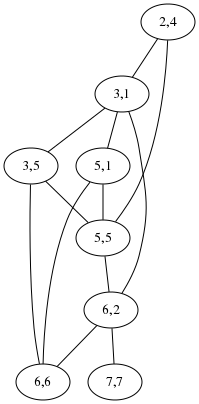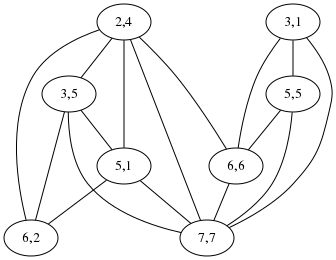Mark Dominus (陶敏修)
mjd@pobox.com

Archive:
| 2025: | JFMAMJ |
| JAS | |
| 2024: | JFMAMJ |
| JASOND | |
| 2023: | JFMAMJ |
| JASOND | |
| 2022: | JFMAMJ |
| JASOND | |
| 2021: | JFMAMJ |
| JASOND | |
| 2020: | JFMAMJ |
| JASOND | |
| 2019: | JFMAMJ |
| JASOND | |
| 2018: | JFMAMJ |
| JASOND | |
| 2017: | JFMAMJ |
| JASOND | |
| 2016: | JFMAMJ |
| JASOND | |
| 2015: | JFMAMJ |
| JASOND | |
| 2014: | JFMAMJ |
| JASOND | |
| 2013: | JFMAMJ |
| JASOND | |
| 2012: | JFMAMJ |
| JASOND | |
| 2011: | JFMAMJ |
| JASOND | |
| 2010: | JFMAMJ |
| JASOND | |
| 2009: | JFMAMJ |
| JASOND | |
| 2008: | JFMAMJ |
| JASOND | |
| 2007: | JFMAMJ |
| JASOND | |
| 2006: | JFMAMJ |
| JASOND | |
| 2005: | OND |
Subtopics:
| Mathematics | 245 |
| Programming | 99 |
| Language | 95 |
| Miscellaneous | 75 |
| Book | 50 |
| Tech | 49 |
| Etymology | 35 |
| Haskell | 33 |
| Oops | 30 |
| Unix | 27 |
| Cosmic Call | 25 |
| Math SE | 25 |
| Law | 22 |
| Physics | 21 |
| Perl | 17 |
| Biology | 16 |
| Brain | 15 |
| Calendar | 15 |
| Food | 15 |
Comments disabled
Thu, 23 Feb 2017
Miscellaneous notes on anagram scoring
My article on finding the best anagram in English was well-received, and I got a number of interesting comments about it.
A couple of people pointed out that this does nothing to address the issue of multiple-word anagrams. For example it will not discover “I, rearrangement servant / Internet anagram server” True, that is a different problem entirely.
Markian Gooley informed me that “megachiropteran / cinematographer” has been long known to Scrabble players, and Ben Zimmer pointed out that A. Ross Eckler, unimpressed by “cholecystoduodenostomy / duodenocholecystostomy”, proposed a method almost identical to mine for scoring anagrams in an article in Word Ways in 1976. M. Eckler also mentioned that the “remarkable” “megachiropteran / cinematographer” had been published in 1927 and that “enumeration / mountaineer” (which I also selected as a good example) appeared in the Saturday Evening Post in 1879!
The Hacker News comments were unusually pleasant and interesting. Several people asked “why didn't you just use the Levenshtein distance”? I don't remember that it ever occured to me, but if it had I would have rejected it right away as being obviously the wrong thing. Remember that my original chunking idea was motivated by the observation that “cholecystoduodenostomy / duodenocholecystostomy” was long but of low quality. Levenshtein distance measures how far every letter has to travel to get to its new place and it seems clear that this would give “cholecystoduodenostomy / duodenocholecystostomy” a high score because most of the letters move a long way.
Hacker News user
tyingqtried it anyway, and reported that it produced a poor outcome. The top-scoring pair by Levenshtein distance is “anatomicophysiologic physiologicoanatomic”, which under the chunking method gets a score of 3. Repeat offender “cholecystoduodenostomy / duodenocholecystostomy” only drops to fourth place.A better idea seems to be Levenshtein score per unit of length, suggested by lobste.rs user
cooler_ranch.A couple of people complained about my “notaries / senorita” example, rightly observing that “senorita” is properly spelled “señorita”. This bothered me also while I was writing the article. I eventually decided although “notaries” and “señorita” are certainly not anagrams in Spanish (even supposing that “notaries” was a Spanish word, which it isn't) that the spelling of “senorita” without the tilde is a correct alternative in English. (Although I found out later that both the Big Dictionary and American Heritage seem to require the tilde.)
Hacker News user
ggambettaobserved that while ‘é’ and ‘e’, and ‘ó’ and ‘o’ feel interchangeable in Spanish, ‘ñ’ and ‘n’ do not. I think this is right. The ‘é’ is an ‘e’, but with a mark on it to show you where the stress is in the word. An ‘ñ’ is not like this. It was originally an abbreviation for ‘nn’, introduced in the 18th century. So I thought it might make sense to allow ‘ñ’ to be exchanged for ‘nn’, at least in some cases.(An analogous situation in German, which may be more familiar, is that it might be reasonable to treat ‘ö’ and ‘ü’ as if they were ‘oe’ and ‘ue’. Also note that in former times, “w” and “uu” were considered interchangeable in English anagrams.)
Unfortunately my Spanish dictionary is small (7,000 words) and of poor quality and I did not find any anagrams of “señorita”. I wish I had something better for you. Also, “señorita” is not one of the cases where it is appropriate to replace “ñ” with “nn”, since it was never spelled “sennorita”.
I wonder why sometimes this sort of complaint seems to me like useless nitpicking, and other times it seems like a serious problem worthy of serious consideration. I will try to think about this.
Mike Morton, who goes by the anagrammatic nickname of “Mr. Machine Tool”, referred me to his Higgledy-piggledy about megachiropteran / cinematographer, which is worth reading.
Regarding the maximum independent set algorithm I described yesterday, Shreevatsa R. suggested that it might be conceptually simpler to find the maximum clique in the complement graph. I'm not sure this helps, because the complement graph has a lot more edges than the original. Below right is the complement graph for “acrididae / cidaridae”. I don't think I can pick out the 4-cliques in that graph any more than the independent sets in the graph on the lower-left, and this is an unusually favorable example case for the clique version, because the original graph has an unusually large number of edges.


But perhaps the cliques might be easier to see if you know what to look for: in the right-hand diagram the four nodes on the left are one clique, and the four on the right are the other, whereas in the left-hand diagram the two independent sets are all mixed together.
An earlier version of the original article mentioned the putative 11-pointer “endometritria / intermediator”. The word “endometritria” seemed pretty strange, and I did look into it before I published the article, but not carefully enough. When Philip Cohen wrote to me to question it, I investigated more carefully, and discovered that it had been an error in an early WordNet release, corrected (to “endometria”) in version 1.6. I didn't remember that I had used WordNet's word lists, but I am not surprised to discover that I did.
A rare printing of Webster's 2¾th American International Lexican includes the word “endometritriostomoscopiotomous” but I suspect that it may be a misprint.
Philippe Bruhat wrote to inform me of Alain Chevrier’s book notes / sténo, a collection of thematically related anagrams in French. The full text is available online.
Alexandre Muñiz, who has a really delightful blog, and who makes and sells attractive and clever puzzles of his own invention. pointed out that soapstone teaspoons are available. The perfect gift for the anagram-lover in your life! They are not even expensive.
Thanks also to Clinton Weir, Simon Tatham, Jon Reeves, Wei-Hwa Huang, and Philip Cohen for their emails about this.
[ Addendum 20170507: Slides from my !!Con 2017 talk are now available. ]
[ Addendum 20170511: A large amount of miscellaneous related material ]
[Other articles in category /lang] permanent link


